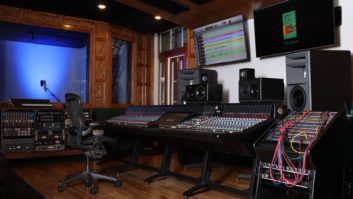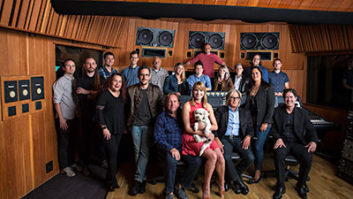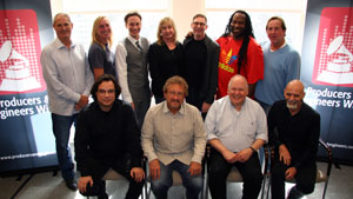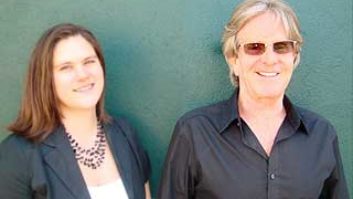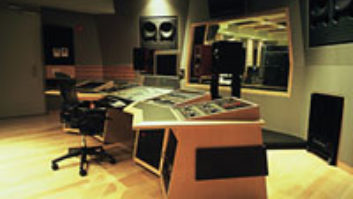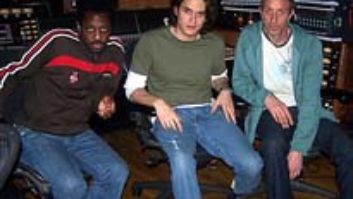At The Village in Los Angeles, John Alagia and engineer Brian Scheuble sit at the console tracking the new Liz Phair album. Not one to just camp out between two speakers, Alagia also sits at the B3 overdubbing some tasty organ licks and occasionally hoisting a bass or guitar. Checking out Alagia’s credits, you’ll find him listed as a producer/engineer/mixer/musician, and the artists he has influenced include Dave Matthews, John Mayer, Jason Mraz, Simon & Garfunkel, Lifehouse, Ben Folds Five, O.A.R. and Rachael Yamagata, among many others.
A resident of Maryland’s Chesapeake Bay region, Alagia is tall, affable, modest, polite and — judging from the steady string of successful work he has produced during the past decade-and-a-half — one of the more musically gifted people working today. Some may call him a Renaissance man, but Alagia would most likely blush profusely if introduced as such, so we decided to have a fireside chat and see what makes the man tick.
First, where were you born, raised and educated?
I was born in Louisville, Kentucky, and lived there until I was 18, when I left to study at Georgetown University in Washington, D.C. I graduated in 1986 with a degree in English Literature, but I was playing music throughout my school years. I was supposed to become a lawyer, but that didn’t work out. I played rock ‘n’ roll at night, and made demos playing keyboards, guitars and drums. I had a TEAC 4-track recorder, and then moved up to a Tascam 8-track with dbx Noise Reduction. I didn’t really have any training as an engineer, except for a seminar at Omega Studios in Rockville, Maryland. I learned mostly from being in studios and watching folks that had experience. Bob Dawson at Bias Studios, outside of Washington, D.C., taught me quite a bit.
When you were a kid, did you have music in the house?
Yes, and I was the youngest of five kids. My brothers and sisters had lots of 45s and LPs. One of the first songs I can remember is “Winchester Cathedral,” and music on the Ed Sullivan Show, Looney Tunes and Henry Mancini’s “Theme From Pink Panther.” I was the only one who wasn’t forced to take musical lessons, but I did study piano and guitar a little bit. I learned to play mostly by ear, and I took a semester at the Berklee College of Music to study theory.
How did you get from college to the minor leagues?
When I was a senior in college, I met an incoming freshman named Doug Derryberry. He was the first musical genius I ever met — plays almost every instrument, he sings, he writes — and we still work together today. We got together in college and formed a partnership called Derryberry and Alagia. We played up and down the East Coast in colleges and clubs, and we made three records. His knowledge of music was so broad and he opened up my ears to all types of interesting music. We made our own acoustic-based folk/rock/pop records. We took a lot of time learning how to get things to tape and experimenting by ourselves recording our own material. I got to engineering just out of necessity to get the sounds I wanted.
During our journeys on the road, we found ourselves working alongside other bands in the same towns on that circuit. That’s how we met Ben Folds and Dave Matthews. I met Dave back in 1992, and it was just serendipitous the way it worked out. I had taken a local band, Kevin Johnson and The Linemen, down to record at Ardent Studios in Memphis and had five days to make a record with them. Dave Matthews had been at Ardent a few months prior to our sessions. Ross Hoffman, who was Dave’s agent at the time, called up Ardent and said they were looking for someone to work with him in the mid-Atlantic area. The folks at Ardent mentioned me and the work I was doing
Just around that time, I had been at a bar in Washington, D.C., and had heard the Dave Matthews Band playing, with an audience of about 75 people. I couldn’t believe what I was seeing and was wondering how the hell you could capture that sound on tape. They were the best thing I had ever seen live. I told everyone I knew that this band would have a greater impact on music than anything we had seen in a long, long time — right up there with U2, The Beatles. The very next day, I got a call from Dave’s agent about my recommendation from the folks at Ardent.
I started going down to Charlottesville and Richmond, Virginia, every Tuesday and Wednesday to the clubs Trax and The Floodzone and recorded their shows. It was just live recording, but if it sounded good, we were thinking of releasing it as just a snapshot of the band. At that time, Dave was just interested in refining his sound. They were also doing some recording at Flat Five studio in Salem, Virginia. So they brought me into the studio to help finish up some of those recordings. I was unhealthily obsessed. I pulled back my performance schedule and put my guitar aside after hearing what Dave was doing. I became focused more in the studio and much less on the road. Every once in a while, Dave would come up to my house and record some new ideas, which he would then take back to the band.
Slowly, we decided to do an official live record with a couple of studio tracks and that became Remember Two Things, their first record. It was in June 1993 that Dave asked if I would like to help produce that record. Between July 1992 and November 1993, we had this informal recording process. I bought some of the first ADATs in June that year, traveled with the band and recorded live shows through the summer. Then we did some overdubs, some vocals and guitars. I wasn’t thinking so much about the possible commercial success as I was about how important and how wonderful this music was. I was pretty shy around those guys and was humbled by the mightiness of their music.
I spent months on end with Dave at his house in Virginia, helping with the pre-production for Crash and Before These Crowded Streets. We’d sit around with a couple of guitars and he’d be pouring out all these little musical ideas that would eventually become some of his biggest hits like “Crash,” “Too Much,” “Crush,” “Stay” and so on. I feel mighty lucky to know him and to have worked with him. He taught me quite a bit.
What a great way to get your career in gear. Are you using those same recording/producing techniques now?
You learn from every experience and I have come into contact with so many amazing producers and engineers since then. I’ve learned a lot from working here with Brian Scheuble on Liz Phair’s album at The Village.
Are you recording to tape?
No, we’re recording straight to Pro Tools. I brought out my RADAR recorder from my studio back home just to A/B. I’m using Apogee 8016 converters, recording at 96k. Brian is setting up all mics, and I may dabble a bit with the EQ and compression. I’ve worked a lot since 1997 with an engineer named Jeff Juliano — we almost morphed into one brain for the recording process. I worked more on the music side and he concentrated on the engineering, but it became a dual effort between us.
Is there a difference between these two engineers’ approaches?
Mic selection, for one. Brian is using [Neumann] 67s and 87s for overheads, and I have mostly used [AKG] 414s in the past with Jeff. Brian uses compression differently, and for EQ, he likes to dial up the midrange, whereas Jeff would tend to dial it out. But you can’t get too hung up in the details — you’ve just got to listen and decide what sounds good at the time you are working.
You recorded Liz and the band live in a big room. Is that your favorite way to record?
I think you get better performances with more people playing in a close environment. I think it’s best not to overthink the overdubbing process. It’s such a mystery to me how records end up becoming what they become. I’m not a guy who has a grand vision beforehand, like it’s got to be exactly 112 beats per minute. I like to put everyone in the room at the same time and then listen to the drummer: 112 might sound like 115 or 120. You’ve just gotta try it out. Hopefully, everyone’s checked their ego at the door.
How would you compare producing live recordings with studio productions?
Live is more a job of organizing the recording event and overseeing it. From a production point of view, it’s more of a surgical effort and the correcting of things. In a studio environment, you try to bring together the best team for the job. I try to make it as comfortable as possible for those who are recording.
How did Liz find you?
I met Liz a few years ago at South by Southwest after finishing John Mayer’s first record. She told me how much she loved it. Then she heard my work with Jason Mraz and Rachael Yamagata, and she liked those albums, too. I really liked her as an artist, and I got a call last December to see if I could get together with her and talk about her recording. I flew out one morning to L.A. from Baltimore, had breakfast and then flew back home. We talked about the concept and we agreed on all points.
I gravitate toward the strong songwriters and do my best to help them communicate to the listener. I have a lot of respect for Liz — she’s really individualistic and has her own distinct way.
Did she play ideas or demos for you?
Yes, she sent me some demos that were really great. The more I do this job, the more I am amazed at how good the demos are these days. In many cases, they could be the masters — depending on the labels and the politics, of course. She came into the studio with the same guys she had on the demos, and they did a great job. I think I was brought in because I could bring some objectivity because it’s difficult to produce your own record.
I’ve produced my own work and I wish I could have had someone come in with a new and objective view. When we were making the Derryberry and Alagia records, we made an ungodly number of mistakes, and I wish they had never been recorded. Someone should have been kicking our asses to make it better and told us some of the lyrics were a bit dodgy.
You also play on Liz’s album. I liked your B3 overdub, especially the way you stopped yourself in the middle of a take three or four times until you had what was working. What else?
I play some guitar, but I don’t want to step on anyone’s toes. I don’t need to play on the records, but if I have something that might fill a gap, I will throw it in. I don’t want to have my stamp on a record; I want to help the artist get their essence recorded well. The music producer is like a film director — you are a motivator and, hopefully, a big picture person, and you most of all want the artist to feel comfortable to yield the best results.
I learned a lot from Steve Lillywhite. After listening to a record I had just produced, he told me, “John, this is just such a beautiful, squeaky-clean record. There isn’t one mistake.” I asked what he meant, and he replied, “Well, not one of your records has mistakes.” I got upset with that, and there was a point 12 years ago where I was trying to make everything fit right inside the lines. What he said hit me hard. It’s easy these days working in Pro Tools to just put that waveform up on the grid and make it perfect. It’s a phase you go through, but there is no such thing as perfection in the real world. I don’t want to be a detective producer looking for each and every error; I just like to record the track as if it was going straight to a tape machine.
Did you work with John Mayer on “Daughters”?
No, he did that all on his own right after we finished his album. He was actually down in New Zealand and wrote it in his hotel room. He played me his demo and it was flawless; a perfect little tune.
How did you first meet John?
I met him through Courtney Hard and Sue Devine at ASCAP. I was paying a visit in New York and they had John on the phone. Courtney told me that he played great guitar. I heard a demo, and not only was he a monster guitar player, but he could write beautiful songs. We started a friendship over the phone and I flew down to help him record a live gig in Atlanta a few months later. We started talking about making a record and we drew up the list of songs. I got him a drummer — he had a bass player — and we just jumped into Loho Recording in New York City. We did the basics in eight days and then finished it up at my studio in Maryland. Room for Squares was done top-to-bottom in 28 days. We also did some more mixes with Jack Joseph Puig at Ocean Way in Hollywood.
Any other studios you like to work at?
It’s been great working at The Village — great gear and really nice people. I love The Magic Shop in New York City. I like working with John Altschiller at his Chiller Sound studio. And I love my little studio in Maryland.
Do you have any favorite microphones?
I just bought an old Neumann 269 that I like a lot. I cut most male vocals through a Shure SM7 through a [Neve] 1073 mic pre. I also have a pair of Neve 33102s, which I love. I usually hit it with a Tube-Tech LCA-2B stereo [compressor] and then sometimes the Distressor. That’s pretty much the vocal chain.
What kind of console do you have at your home studio?
I don’t have a console; I have ProControl and an API 16-channel summing amp, which acts like a console. Oh, I forgot to mention the Universal Audio 610 preamps. Great pre-amp. I love all their products. I like the Focusrite ISA-215, a great surgical EQ and a great preamp. I guess I am a gearhead, but I really love instruments more than gear. I’ve got lots of toys, but not to the degree of [producer/musician] Jon Brion. I saw him perform last Friday night at Largo [L.A.] — he makes me dizzy with inspiration.
Speaking of inspiration, who did you look up to in your formative years?
George Martin and Phil Ramone are the two that first come to mind.
How did you get to work with Herbie Hancock and Paul Simon last week?
I worked with Art Garfunkel on a Paul Simon track about a year-and-a-half ago. It was going to be on [Simon’s] Hearts and Bones, but Paul didn’t feel like it quite made it. Paul thought I did a good job on it and invited me up to his house to listen to his new material he was working on with Brian Eno. I really don’t know how I ended up on the Herbie session, but was secretly hoping that Paul had something to do with it. Ends up that I’ve worked with a few other artists who share Herbie’s manager, so I went over to meet him at his house and ended up spending hours and hours with him, just listening to music and talking. We talked about technology and music, and he is such a fine man.
The track we did is for Herbie’s record, and because he’s touring and such a busy man, he asked me if I would produce it. We had a concept, and we were working on the charts in the hotel the night before we went into the studio. Paul came in a day early and he had some ideas. I could hardly believe it: Here I was playing Paul’s guitar part with him singing, and Herbie on piano, Pino Palladino on bass, Steve Jordan on a champagne kit, and Jamey Haddad and Cyro Battista on percussion. It was a great little group of folks to have in the studio at the same time. Paul was talking about how a musician making music is similar to a preacher who is giving a sermon. Those few days in the studio were a remarkable time for me.
What is your responsibility as a producer?
To create a team of people that will achieve the best results for the artist. You’ve got to have mutual respect with the people you work with. Music is a wonderful mystery, and the making of it, the process, should never be taken too seriously. Focus and have a good time at it.
Ideally, a great artist and producer challenge each other and together yield great results. I respect the artists I work with, and if there is any disagreement on the creative side, I’ll most likely bow to them, as their talent is what brought me to them. They are the reason we producers and engineers do what we do. No producer has the right to ever say he made an artist, at least not a great artist. Helpful, yes, but not a maker.
Photographer and author Mr. Bonzai is currently working on a collection of his photos and interviews titled Faces of Music: 25 Years of Lunching With Legends. Visit
www.mrbonzai.com
for more information.
